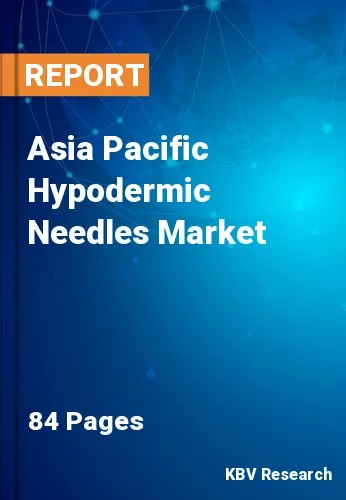The Asia Pacific Hypodermic Needles Market would witness market growth of 3.7% CAGR during the forecast period (2022-2028).
A hypodermic needle also enables liquids drugs to be provided quickly to the patients. It's also employed when the injected chemical cannot be taken orally because it wouldn't be absorbed (like insulin) or would injure the liver. Hypodermic needles are also useful in research that requires sterile settings. In two ways, the hypodermic needle reduces contamination during the inoculation of a sterile substrate. For example, its smooth surface prevents airborne infections from becoming caught between irregularities on the needle's surface and being passed into the media as contaminants. Additionally, because the needle's point is exceptionally sharp, it reduces the diameter of the hole left after puncturing the membrane, preventing bacteria larger than the hole from infecting the substrate.
Numerous special-purpose syringe sets and syringes are included in the collection. Doctors and specialists used the anesthetic syringe set frequently. The thick metal syringe with a sturdy screw lock and copper-cased cannulas retain heat, allowing the injection of molten paraffin wax into empty organs and vessels for demonstration specimens in morbid anatomy lessons. In addition, the applications of hypodermic needles are estimated to increase in the coming years. These factors are anticipated to expedite the growth of the hypodermic needles market.
China is showcasing an increased focus on enhancing the healthcare infrastructure of the country. According to the International Trade Administration, since January 2021, China's National Medical Products Administration (NMPA, the equivalent of the US FDA) has required the Unique Device Identification (UDI) marking on some Class III medical devices. By March 1, 2022, this enforcement was estimated to be expanded to include all Class III medical equipment. The medical device industry claims that UDI would align China's medical device legislation with worldwide norms and practices, as well as increase medical device safety through improved traceability as well as post-market surveillance. China's central government has set the objective of adopting the national healthcare policy, Healthy China 2030, to improve the well-being of its inhabitants. One of the major tasks is to strengthen the country's hierarchical medical system. Medical institutes and clinical labs will be established and strengthened as part of this strategy.
The China market dominated the Asia Pacific Hypodermic Needles Market by Country in 2021, and would continue to be a dominant market till 2028; thereby, achieving a market value of $439.8 million by 2028. The Japan market is estimated to grow at a CAGR of 3% during (2022 - 2028). Additionally, The India market would witness a CAGR of 4.3% during (2022 - 2028).
Based on Product, the market is segmented into Safety and Non-safety. Based on Application, the market is segmented into Drug Delivery, Vaccination and Blood Specimen Collection. Based on End Users, the market is segmented into Hospital, Diabetic Patients, Family Practitioners, Psychiatry and Others. Based on countries, the market is segmented into China, Japan, India, South Korea, Singapore, Malaysia, and Rest of Asia Pacific.
Free Valuable Insights: The Worldwide Hypodermic Needles Market is Projected to reach USD 4.2 Billion by 2028, at a CAGR of 3.3%
The market research report covers the analysis of key stake holders of the market. Key companies profiled in the report include Becton, Dickinson and Company, Terumo Corporation, Nipro Corporation, Cardinal Health, Inc., B. Braun Melsungen AG, McKesson Corporation, Retractable Technologies, Inc., Connecticut Hypodermics, Inc., Exelint International, Co., and i-Tech Medics Private Limited.
By Product
By Application
By End User
By Country
Our team of dedicated experts can provide you with attractive expansion opportunities for your business.

